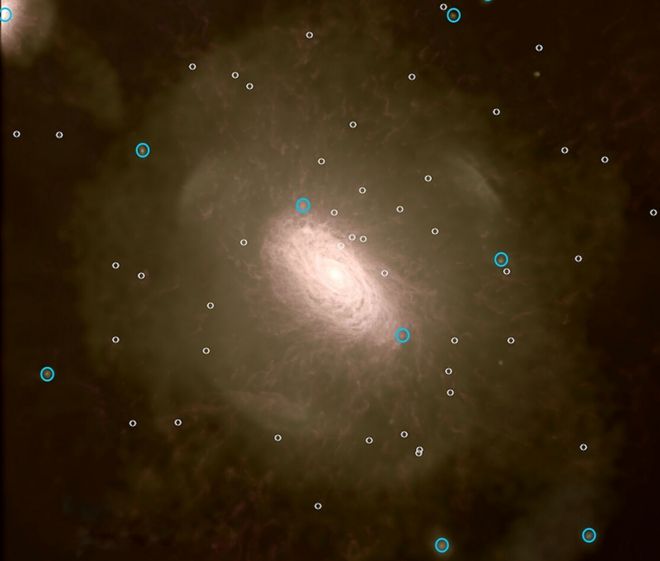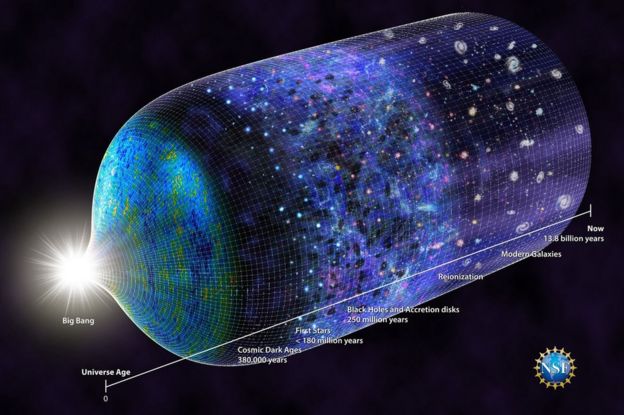Disir
Platinum Member
- Sep 30, 2011
- 28,003
- 9,607
- 910
Young galaxies blaze with bright new stars forming at a rapid rate, but star formation eventually shuts down as a galaxy evolves. A new study, published January 1, 2018, in Nature, shows that the mass of the black hole in the center of the galaxy determines how soon this "quenching" of star formation occurs.
Every massive galaxy has a central supermassive black hole, more than a million times more massive than the sun, revealing its presence through its gravitational effects on the galaxy's stars and sometimes powering the energetic radiation from an active galactic nucleus (AGN). The energy pouring into a galaxy from an active galactic nucleus is thought to turn off star formation by heating and dispelling the gas that would otherwise condense into stars as it cooled.
This idea has been around for decades, and astrophysicists have found that simulations of galaxy evolution must incorporate feedback from the black hole in order to reproduce the observed properties of galaxies. But observational evidence of a connection between supermassive black holes and star formation has been lacking, until now.
"We've been dialing in the feedback to make the simulations work out, without really knowing how it happens," said Jean Brodie, professor of astronomy and astrophysics at UC Santa Cruz and a coauthor of the paper. "This is the first direct observational evidence where we can see the effect of the black hole on the star formation history of the galaxy."
The new results reveal a continuous interplay between black hole activity and star formation throughout a galaxy's life, affecting every generation of stars formed as the galaxy evolves.
Led by first author Ignacio Martín-Navarro, a postdoctoral researcher at UC Santa Cruz, the study focused on massive galaxies for which the mass of the central black hole had been measured in previous studies by analyzing the motions of stars near the center of the galaxy. To determine the star formation histories of the galaxies, Martín-Navarro analyzed detailed spectra of their light obtained by the Hobby-Eberly Telescope Massive Galaxy Survey.
Read more at: Supermassive black holes control star formation in large galaxies
That's another cool thang.
Every massive galaxy has a central supermassive black hole, more than a million times more massive than the sun, revealing its presence through its gravitational effects on the galaxy's stars and sometimes powering the energetic radiation from an active galactic nucleus (AGN). The energy pouring into a galaxy from an active galactic nucleus is thought to turn off star formation by heating and dispelling the gas that would otherwise condense into stars as it cooled.
This idea has been around for decades, and astrophysicists have found that simulations of galaxy evolution must incorporate feedback from the black hole in order to reproduce the observed properties of galaxies. But observational evidence of a connection between supermassive black holes and star formation has been lacking, until now.
"We've been dialing in the feedback to make the simulations work out, without really knowing how it happens," said Jean Brodie, professor of astronomy and astrophysics at UC Santa Cruz and a coauthor of the paper. "This is the first direct observational evidence where we can see the effect of the black hole on the star formation history of the galaxy."
The new results reveal a continuous interplay between black hole activity and star formation throughout a galaxy's life, affecting every generation of stars formed as the galaxy evolves.
Led by first author Ignacio Martín-Navarro, a postdoctoral researcher at UC Santa Cruz, the study focused on massive galaxies for which the mass of the central black hole had been measured in previous studies by analyzing the motions of stars near the center of the galaxy. To determine the star formation histories of the galaxies, Martín-Navarro analyzed detailed spectra of their light obtained by the Hobby-Eberly Telescope Massive Galaxy Survey.
Read more at: Supermassive black holes control star formation in large galaxies
That's another cool thang.





